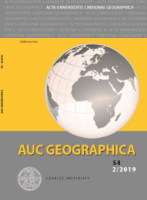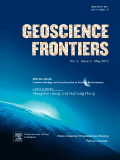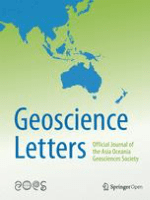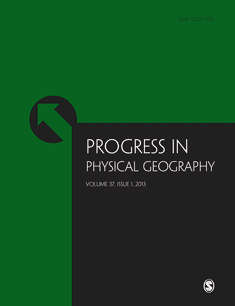
EARTH
Scope & Guideline
Advancing knowledge for a sustainable planet.
Introduction
Aims and Scopes
- Earth Observation and Remote Sensing:
The journal consistently publishes research utilizing satellite data and remote sensing techniques to monitor and analyze environmental changes, land use dynamics, and natural disasters. - Climate Change and Environmental Impact Assessment:
A core focus is on understanding the impacts of climate change on ecological, hydrological, and atmospheric processes, alongside assessments of environmental policies and adaptation strategies. - Sustainable Resource Management:
Research addressing sustainable practices in agriculture, water management, and land use planning are prevalent, highlighting the importance of balancing human needs with environmental health. - Geospatial Analysis and Modeling:
The use of Geographic Information Systems (GIS) and spatial modeling techniques is a recurring theme, facilitating the analysis of complex environmental data and decision-making. - Biodiversity and Ecosystem Services:
The journal explores the relationships between biodiversity, ecosystem functions, and services, aiming to inform conservation strategies and sustainable development. - Socio-Economic Dimensions of Environmental Issues:
Studies examining the intersection of socio-economic factors and environmental challenges are emphasized, focusing on the implications for policy and community engagement.
Trending and Emerging
- Machine Learning and AI in Environmental Science:
There is a growing trend in utilizing machine learning and artificial intelligence for predictive modeling and data analysis in environmental studies, indicating a shift towards more data-driven research methodologies. - Interdisciplinary Approaches to Climate Resilience:
Research integrating multiple disciplines—such as social sciences, ecology, and engineering—to address climate resilience is on the rise, reflecting the need for comprehensive solutions to complex environmental problems. - Public Participation and Community Engagement:
Emerging studies are increasingly focusing on the role of public participation and community involvement in environmental decision-making processes, underscoring the importance of local knowledge and stakeholder engagement. - Impact of Urbanization on Environmental Dynamics:
As urban areas expand, there is heightened interest in studying the effects of urbanization on ecosystems, climate, and resource management, with a focus on sustainable urban planning. - Biodiversity Conservation and Ecosystem Restoration:
The journal is seeing increased publications related to biodiversity conservation strategies and ecosystem restoration efforts, driven by global sustainability goals and environmental degradation concerns.
Declining or Waning
- Traditional Geological Studies:
Research focused solely on classical geological studies appears to be less frequent, as the journal shifts towards more integrative and applied environmental science topics. - Single-Factor Environmental Assessments:
There is a noticeable reduction in studies that analyze environmental issues in isolation, with a trend moving towards multi-factorial approaches that consider the complex interplay of various environmental and socio-economic factors. - Historical Environmental Studies:
Papers concentrating exclusively on historical analyses of environmental changes without contemporary relevance are declining, as current and actionable research takes precedence. - Narrowly Defined Regional Studies:
Research that focuses on specific, limited geographic areas without broader implications or comparative analyses is becoming less common, as the journal encourages wider applicability of findings.
Similar Journals

AUC Geographica
Championing Open Access to Geographic KnowledgeWelcome to AUC Geographica, a distinguished journal published by CHARLES UNIV PRAGUE, KAROLINUM PRESS, focusing on the expansive and interdisciplinary fields of Earth and Planetary Sciences, as well as Geography, Planning, and Development. With an ISSN of 0300-5402 and an E-ISSN of 2336-1980, this Open Access journal has been freely accessible since 2010, allowing researchers, professionals, and students to engage with high-quality scholarly articles without barriers. As of 2023, it holds a Q4 ranking in its respective categories, reflecting its commitment to contributing to the academic discourse despite competitive landscapes. Located in Prague, Czech Republic, at OVOCNY TRH 3/5, PRAGUE 1 116 36, AUC Geographica aims to foster collaboration and innovative research in the multifaceted relationships between human activities and the natural environment. With a publication history spanning from 1975 to 2024, this journal continues to be a vital resource for those seeking to advance knowledge and explore new dimensions in geography and Earth sciences.

Chinese Geographical Science
Advancing Earth Sciences through Global Perspectives.Chinese Geographical Science is a prestigious, peer-reviewed journal published by Springer, dedicated to the dynamic and interdisciplinary fields of Earth and Planetary Sciences and Geography, Planning and Development. With an impressive 2023 Q1 ranking in both categories, the journal supports the dissemination of groundbreaking research from a global perspective, reflecting its significance in the scientific community. The journal is indexed under the highly regarded Scopus database, where it ranks in the top percentile in both Geography and Earth Sciences, illustrating its commitment to excellence and impact within these disciplines. Since its inception in 1991, it has provided a vital platform for researchers and scholars to share their findings, address pressing geographical issues, and contribute to the development of innovative solutions for sustainable development. Although it operates under a subscription model, its rigorous peer-review process ensures that the highest quality of research is published. By fostering collaboration and dialogue among scholars, Chinese Geographical Science plays an essential role in advancing knowledge and shaping policy in geographical sciences and beyond.

Physio-Geo
Navigating the Nexus of Geography and EcologyPhysio-Geo (ISSN: 1958-573X) is a distinguished open-access journal published by REVUES ORG, dedicated to advancing the fields of Earth and Planetary Sciences, with a special focus on Earth-Surface Processes, Environmental Science, and Ecology. Since its inception in 2007, Physio-Geo has provided a platform for researchers, professionals, and students to disseminate and access high-quality studies that contribute to the understanding of our environment. With a convergence period from 2019 to 2024, the journal aims to bridge disciplinary gaps and foster interdisciplinary research that addresses pressing ecological and environmental challenges. Despite its current Scopus rankings reflecting an early-stage development, the journal is poised to enhance its impact within the scientific community, particularly as it embraces a wider audience through its open-access model. By offering valuable insights and comprehensive analyses, Physio-Geo is an essential resource for those seeking to explore the complex interactions between physical geography and ecological systems.

Earth Interactions
Fostering Innovation in Earth and Planetary ResearchEarth Interactions is a prominent journal that serves as a critical platform for interdisciplinary research in the field of Earth and Planetary Sciences. Published by the American Meteorological Society, this journal has established itself as a key resource for scholars, researchers, and professionals dedicated to understanding Earth's complex systems and their interactions. With an impressive Q1 ranking in the category of Earth and Planetary Sciences for 2023, it reflects a commitment to high-quality scholarship and impactful contributions to the field. The journal, with its dedicated coverage from 2004 to 2024, encompasses a wide array of topics, providing comprehensive insights into geological, atmospheric, and environmental phenomena. Although it operates under a non-open access model, its significance is underscored by its placement in the top percentile of Scopus rankings (Rank #89/195), making it an exciting resource for those pursuing advanced studies and applications related to Earth's systems.

Quaestiones Geographicae
Innovating Insights in Earth and Planetary SciencesQuaestiones Geographicae, an esteemed open-access journal published by SCIENDO, serves as a vital platform for scholarly communication in the field of Earth and Planetary Sciences. Since its inception in 1979, the journal has been dedicated to promoting rigorous research and discourse in geography, encompassing a breadth of topics that reflect the dynamic nature of the discipline. With an impressive Impact Factor belonging to the Q3 quartile category, the journal actively contributes to the global scientific community's understanding of geographical phenomena. Its commitment to open-access publishing since 2010 ensures that groundbreaking research is accessible to a wider audience, facilitating collaboration and innovation. As part of its enduring legacy, Quaestiones Geographicae engages researchers, professionals, and students alike, inviting them to explore, share, and expand the boundaries of geographical knowledge.

Geoscience Frontiers
Pioneering Research for a Sustainable PlanetGeoscience Frontiers is a premier open-access journal that has been at the forefront of disseminating impactful research in the field of Earth and Planetary Sciences since its inception in 2010. Published by China University of Geosciences, Beijing, this journal operates from the Netherlands and has gained recognition for its rigorous peer-review process and high standards of scholarship, earning a distinguished position as Q1 in the Earth and Planetary Sciences category. With a Scopus ranking of 5 out of 195, placing it in the 97th percentile, it reflects the journal's commitment to addressing global geological challenges and advancing our understanding of the Earth’s dynamic systems. As an open-access platform, Geoscience Frontiers ensures that vital research is widely accessible, fostering collaboration and innovation among researchers, professionals, and students alike. By providing a forum for cutting-edge discoveries and theories, the journal plays a critical role in shaping the future of geoscientific research and education.

Geoscience Letters
Exploring the Depths of Earth and BeyondGeoscience Letters, published by Springer, is a prominent open-access journal in the field of Earth and Planetary Sciences, recognized for its dedication to advancing knowledge and research in this vital area of study. With a reported impact factor that reflects its esteemed position—ranking in the Q1 quartile of Earth and Planetary Sciences, particularly as the journal ranks #48 out of 195 in the general category according to Scopus—the journal serves as a vital resource for researchers, professionals, and students. Since its inception in 2014, Geoscience Letters has facilitated the dissemination of high-quality research and critical insights, aiming to bridge the gap between scientific discovery and societal needs. Its commitment to open access ensures that the latest findings are readily available to a global audience, thus enhancing collaboration and innovation within the geosciences community.

Present Environment and Sustainable Development
Transforming environmental challenges into sustainable solutions.Present Environment and Sustainable Development, published by ALEXANDRU IOAN CUZA UNIVERSITY PRESS, is a prominent open-access journal dedicated to advancing knowledge in the field of environmental science and sustainable development. Since its inception in 2014, the journal has provided a platform for researchers, professionals, and students to disseminate transformative ideas and innovative research aimed at addressing crucial environmental challenges. With its ISSN 1843-5971 and E-ISSN 2284-7820, it emphasizes the necessity of sustainable practices in contemporary society, facilitating interdisciplinary approaches that unite various fields, including ecology, policy, and socio-economic studies. Based in Iasi, Romania, this journal plays a vital role in fostering international collaboration and dialogue on sustainability, making it an essential resource for anyone committed to understanding and improving the environment for future generations.

PHYSICS AND CHEMISTRY OF THE EARTH
Advancing Earth Science through Interdisciplinary InsightsThe Physics and Chemistry of the Earth is a premier interdisciplinary journal published by Pergamon-Elsevier Science Ltd, dedicated to advancing the understanding of Earth sciences through the integration of geophysical and geochemical perspectives. With an ISSN of 1474-7065 and an E-ISSN of 1873-5193, the journal serves as a critical platform for researchers and professionals to disseminate key findings and innovative methodologies in the realms of geophysics and petrology. As of 2023, it proudly holds a Q2 ranking in both Geochemistry and Petrology and Geophysics, reflecting its robust impact in the scientific community, with Scopus rankings that position it in the top 20% and 32% of its respective categories. Notably, the journal is available in an open-access format, allowing for greater dissemination and accessibility of research contributions. With a publication history spanning from 1992 to 2024, Physics and Chemistry of the Earth stands as a vital resource for ongoing research and discovery in the Earth sciences, making it an essential read for academics and practitioners alike.

Progress in Physical Geography-Earth and Environment
Empowering scholars to navigate Earth’s changing landscapes.Progress in Physical Geography-Earth and Environment is a premier academic journal published by SAGE Publications Ltd, renowned for its contributions to the fields of Earth and Planetary Sciences and Geography. With a distinguished history spanning from 1977 to 2024, this journal maintains a robust Q1 classification in both Earth and Planetary Sciences and Geography, Planning and Development, reflecting its high impact and rigorous scholarly standards. As evidenced by its Scopus rankings, it stands at the forefront of research, positioned in the 89th percentile among leading journals. Progress in Physical Geography aims to facilitate the exchange of innovative research, insights, and methodologies, making it an essential resource for researchers, professionals, and students dedicated to understanding and shaping the natural environment. While currently not designated as an Open Access journal, the wide accessibility of its content, combined with its significant impact factor, underscores its importance within the academic community seeking to advance knowledge and application in geography and environmental sciences.